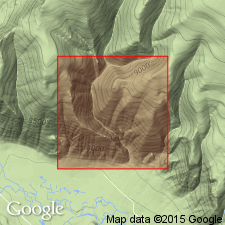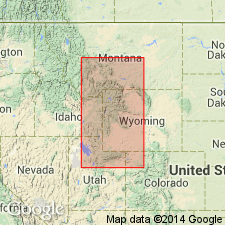
- Usage in publication:
-
- Mackentire red beds tongue
- Modifications:
-
- Original reference
- AAPG geologic province:
-
- Uinta basin
Summary:
p. 91-93. Mackentire red beds tongue of Phosphoria formation. Concomitantly with the thinning of Rex member of Phosphoria, gray and red sandstones, siltstones, and shales appear between the calcareous sandstones and main body of Woodside shale. They are here named Mackentire red beds tongue of Phosphoria. Thickness as much as 100 feet. [Age is Permian.]
Named from exposures at mouth of Mackentire Draw, a small tributary of West Fork of Lake Fork, in sec. 27, T. 2 N., R. 5 W., Uinta Base and Meridian, Duchesne Co., northern UT.
[H.D. Thomas, 1939, AAPG Bull., v. 39, no. 8, p. 1249-1250. Discussion of Williams' paper. Proper designation should be Mackentire red beds tongue of Woodside formation.]
Source: US geologic names lexicon (USGS Bull. 1200, p. 2303).

- Usage in publication:
-
- Mackentire tongue
- Modifications:
-
- Areal extent
- AAPG geologic province:
-
- Uinta basin
Summary:
Pg. 34-35; V.E. McKelvey and others, 1956, AAPG Bull., v. 40, no. 12, p. 2855-2856. Mackentire tongue of Woodside formation. Complex problem of nomenclature of these beds discussed. Report follows Thomas (1939) and Thomas and Krueger (1946, AAPG Bull., v. 30, no. 8, pt. 1) in designating rocks above the Franson in northeastern Utah as Woodside and in considering the Mackentire as tongue of Woodside. Thin beds of purple, greenish-gray, yellowish-orange, and gray shale and siltstone are present in Mackentire at type locality; east of Lake Fork, unit is dominantly greenish-gray and pale yellowish-orange siltstone, some redbeds commonly present. Thins north, east, and west of type locality. Age is Permian.
Source: US geologic names lexicon (USGS Bull. 1200, p. 2303).
For more information, please contact Nancy Stamm, Geologic Names Committee Secretary.
Asterisk (*) indicates published by U.S. Geological Survey authors.
"No current usage" (†) implies that a name has been abandoned or has fallen into disuse. Former usage and, if known, replacement name given in parentheses ( ).
Slash (/) indicates name conflicts with nomenclatural guidelines (CSN, 1933; ACSN, 1961, 1970; NACSN, 1983, 2005, 2021). May be explained within brackets ([ ]).

